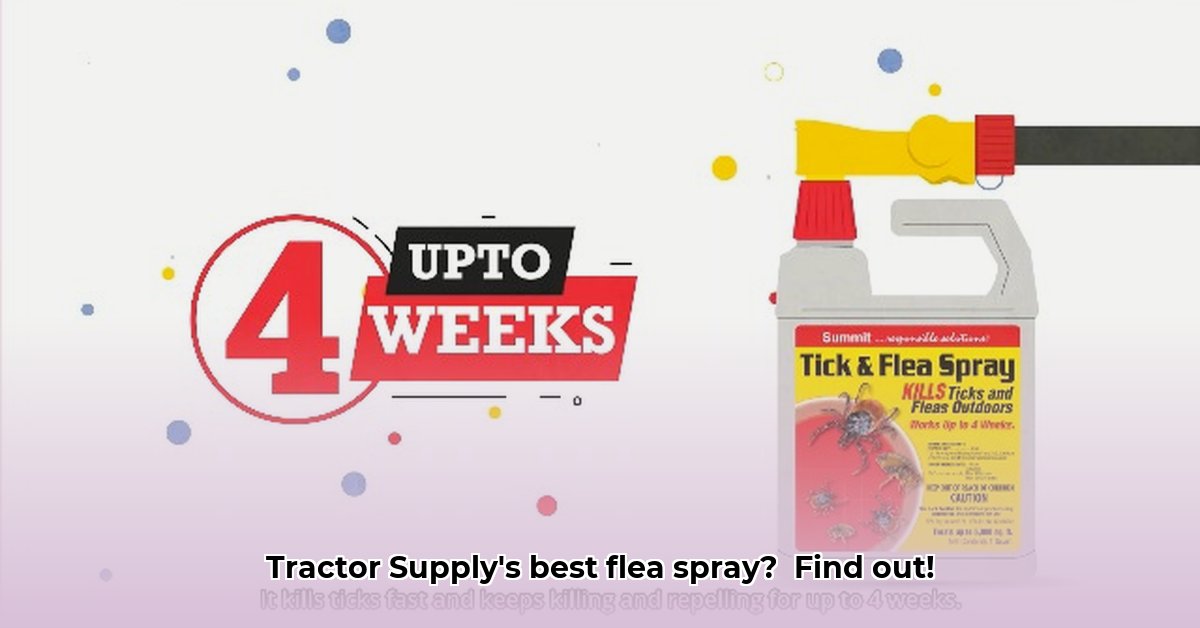
Dealing with fleas is a frustrating experience for pet owners and homeowners alike. Tractor Supply offers a range of flea sprays to combat these pests, but choosing the right one can be overwhelming. This guide helps you navigate the options, select the most effective product for your needs, and apply it safely. We'll explore key factors to consider, ensuring a flea-free environment for you and your pets. For broader pest control, consider other options like Tractor Supply pest control.
Understanding Your Flea Problem: A Crucial First Step
Before diving into product selection, identify the extent of your flea infestation. Are fleas primarily affecting your pets, your home, or your yard? Is it a minor issue, or a significant infestation requiring a broader approach? This assessment guides your choice of flea spray and its application method. A localized pet infestation requires a different strategy than a full-blown yard infestation.
Choosing the Right Flea Spray: Key Considerations
While specific product details from Tractor Supply are unavailable for detailed comparison, the following factors are crucial for effective flea control:
Active Ingredients: The Heart of the Matter
Examine each product's label for its active ingredients. Commonly used and effective components include pyrethroids (such as permethrin or bifenthrin) and fipronil. However, always review the entire ingredient list for potential allergies in you or your pets. Remember, understanding the active ingredients is key to choosing the right and safest option for your specific needs.
Coverage Area and Cost-Effectiveness
Consider how much area each spray covers. Larger properties require greater coverage. Calculate the cost per square foot or per pet to determine the most cost-effective option for your needs. Don't solely focus on the initial price; consider long-term value by calculating the cost per unit of effective area. A more expensive, higher-concentration spray might prove more economical in the long run.
Pet Safety: Prioritizing Your Furry Friends
If applying spray to pets, prioritize products designed for animal use. Follow label instructions meticulously, avoiding contact with eyes, nose, and mouth. Consider the active ingredient's potential impact on your specific animal. Some sprays are better suited for specific breeds or age groups.
Applying Flea Spray Effectively: A Step-by-Step Guide
Effective flea control requires correct application. Follow these steps for optimal results:
Read the Label: Thoroughly understand all instructions and safety precautions before beginning. This critical step protects both you and your pets.
Protective Gear: Wear gloves and eye protection to prevent skin contact with the spray. This precaution safeguards your health and avoids risks associated with accidental exposure.
Strategic Application: Spray evenly over affected areas, focusing on flea hotspots. Avoid overspraying; thorough, even coverage is more effective than excessive application.
Pet Application (If Applicable): If using on pets, apply the spray to their fur, meticulously avoiding eyes, nose, and mouth. Follow the manufacturer’s instructions precisely, maintaining a safe distance from sensitive areas.
Outdoor Application: When spraying outdoors, choose a calm, windless day to prevent spray drift and protect surrounding plants and wildlife. Proper disposal of containers is also critical to minimizing environmental impact.
Drying Time: Allow treated areas to dry completely before allowing pets or children back into the area. This ensures the product's effectiveness and prevents accidental exposure.
Reapplication: Follow the product label's instructions regarding reapplication frequency to maintain ongoing flea control. Regular monitoring of the infestation is recommended to assess the spray's efficacy.
Weighing the Pros and Cons of Flea Sprays
Like any pest control method, flea sprays have advantages and drawbacks.
Pros:
- Rapid Action: Effective at quickly eliminating existing fleas.
- Broad Coverage: Treats large areas efficiently.
- Potentially Cost-Effective: Can be more affordable than other methods depending on infestation size and product selection.
Cons:
- Potential Toxicity: Some ingredients can harm pets, children, or beneficial insects if misused. Improper application or inadequate safety measures can lead to adverse effects.
- Repeated Applications: Often requires multiple applications for complete eradication.
- Environmental Impact: Certain sprays may negatively affect wildlife or pollute water sources if not used responsibly.
Consider a comprehensive approach combining flea spray with other control measures, such as vacuuming, pet treatments, and yard maintenance. Consult your veterinarian for persistent infestations or concerns.
Key Takeaways:
- Thoroughly research different treatment types before purchasing.
- Consider your pet's breed, age, and health when selecting a product.
- Always follow product instructions carefully for safety and effectiveness.
- Consult your veterinarian for personalized advice on flea control.
- Maintain a clean environment to minimize flea exposure.
This guide provides essential information to choose and effectively use flea spray. Remember to always consult the product label and seek professional advice for severe infestations or concerns.